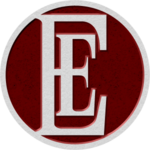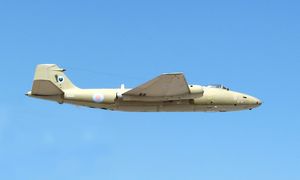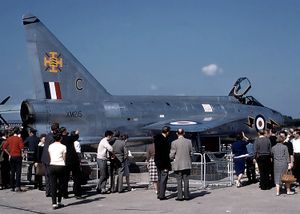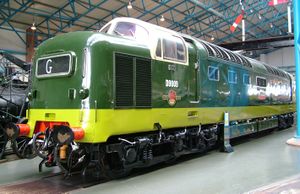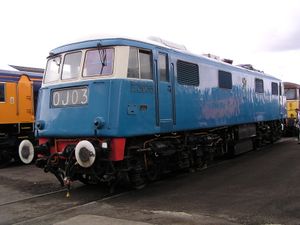English Electric
English Electric was a 20th-century British industrial manufacturer, initially of electric motors, and expanding to include railway locomotives and aviation, before becoming part of GEC.
Contents
History
- 1917: Dick, Kerr & Co. acquired the United Electric Car Company, who made trams in Preston.
- 1918: The English Electric Company was formed.
- 1918 & 1919: EEC took over Dick, Kerr & Co. of Preston (England), Willans & Robinson of Rugby, and the Phoenix Dynamo Manufacturing Company of Bradford. It also bought the Stafford works of Siemens Bros, Dynamo Works Ltd. Dick, Kerr & Co.'s traction activities were concentrated in Preston and continued there until 1930. Also included was Coventry Ordnance Works Ltd.
- 1926 Aicraft department closed after last English Electric Kingston flying boat built.
- 1930: The manufacture of electrical equipment was moved to Bradford. Tramcar, bus body, and rolling stock production stayed at Preston.
- Late 1920s: EE was in a parlous financial state. A complex financial reorganisation, apparently backed by American Westinghouse interests, was needed to save it.
- 1930: The man most associated with EEC, George Nelson, became managing director.
- 1930s: EE supplied equipment for the electrification of the English Southern Railway system, which gave it a strong position in the traction market.
- 1939: EE acquires Samlesbury Aerodrome in Lancashire and starts construction of the Handley Page Hampden and Handley Page Halifax
- 1939-1945 (World War II): EE made a substantial contribution to the British war effort.
- 1942: EE took over Napier & Son, an aero-engine company, and this helped establish the company's aircraft division. Company factories were converted to build the Handley-Page Halifax heavy bomber.
- 1945 and after: EE invested heavily in aircraft design, leading to major successes in the 1950s with the Lightning interceptor and Canberra tactical bomber, which in 2005 was still flying in reconnaissance and other roles with many air forces, including the RAF.
- 1946: EE took over the Marconi Company. This was a foray into domestic markets.
- 1955: EE took over Vulcan Foundry and Robert Stephenson and Hawthorne, both with substantial railway engineering pedigrees. EE also made steam turbines.
- 1958: EE's aviation business was set up separately, as English Electric Aviation Ltd.
- 1960: EE tried to take over one of the other major British electrical companies, GEC.
- Early 1960s : Under government pressure EE rationalised its aircraft division, which later became part of the new British Aircraft Corporation (BAC), English Electric having a 40% stake in BAC.
- 1963: English Electric's guided weapons division added to BAC.
- 1967: GEC took over AEI.
- 1967 or 1968: Failed bid for EE by Plessey.
- 1968: The new GEC conglomerate took over EE.
Products
Aircraft
Bothe Dick Kerr and Phoenix Dymano companies had built aircraft in the First World War - flying boats desinged by the Seaplane Experimental Station at Felixstowe. The Kingston was flying boat design of the Phoenix company when it joined English Electric.
The first forays by English Electric into aircraft production was given up in 1926. The return of English Electric to aircraft building came from the undertaking during the expansion of the RAF prior to the Second World War of "shadow production" of other aircraft manufacturers designs. This started with production of the Handley Page Hampden bomber in 1938. English Electric built nearly 800 aircraft; more than half of the Hampdens produced. They then built Handley Page's heavy bomber the Halifax. At the end of the war they entered production of the second British jet fighter, the de Havilland Vampire with 1,300 plus built at Samlesbury. Their own design work took off post war under W. E. W. Petter, formerly of Westland Aircraft. Although EE had only two aircraft produced before their activities became part of BAC, the design team put forward suggestions for many Air Ministry projects.
- Wren 1923
- Kingston 1924
- Canberra 1949
- English Electric P1A (the Lightning prototype)
- Lightning 1954
Computers
English Electric initial computing interests came about through agreements with RCA. They ultimately ended up as part of ICL. In 1963 EE merged the computing business of J Lyons (their LEO computers) with their own forming English Electric LEO. In 1964 Lyons sold their share to Marconi; th emerger of Marconi and EE LEO gave English Electric Leo Marconi Computers. This would then form part of ICL.
- English Electric DEUCE 1955
- English Electric KDF8
- English Electric KDF9 1960
- English Electric Computers System 4 1965: System 4 was a range of computers. The System 4-50 and System 4-70 were essentially RCA Spectra 70 clones of the IBM System/360 range.
Guided weapons
Tank production
- Excelsior A33 Tank - prototype
Railway Equipment
Engines
Locomotives and Multiple Units
- British Rail Class 08
- British Rail Class 09
- British Rail Class 11
- British Rail Class 12
- British Rail Class 13
- English Electric Type 1 (British Rail Class 20)
- British Rail Class 23
- English Electric Type 3 (British Rail Class 37)
- British Rail Class 40
- English Electric Type 4 (British Rail Class 50)
- English Electric Type 5 (British Rail Class 55)
- British Rail Class 73, components assembled by BR.
- British Rail Class 83
- British Rail Class 86
- British Rail Class 487
- British Rail D0226
- British Rail DP1
- British Rail DP2
- British Rail GT3
- CP Class 1400
- CP Class 1800
- Keretapi Tanah Melayu Class 15
- Keretapi Tanah Melayu Class 20[1]
- Keretapi Tanah Melayu Class 22[2]
- Nigerian Class 1001
- NIR 1 Class
- NS 500 Class
- NS 600 Class
- NZR DE class
- NZR DF class
- NZR DG class
- NZR DI class
- NZR DM class
- NZR E class (battery electric)
- NZR EO class
- NZR EW class
- QR 1200 Class
- QR 1250 Class
- QR 1270 Class
- QR 1300 Class
- QR 2350 Class
- TGR X class
- PKP class EU06
